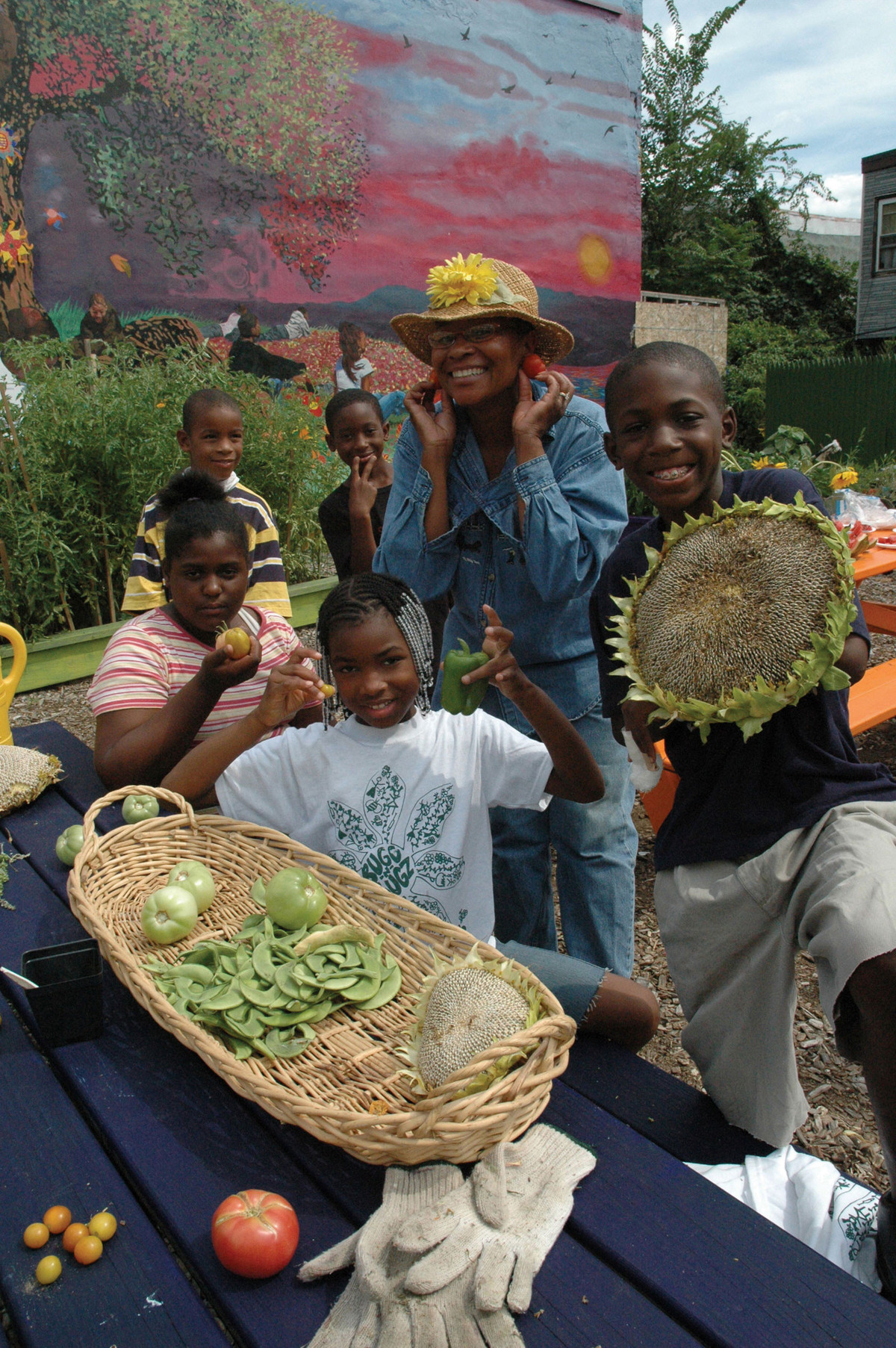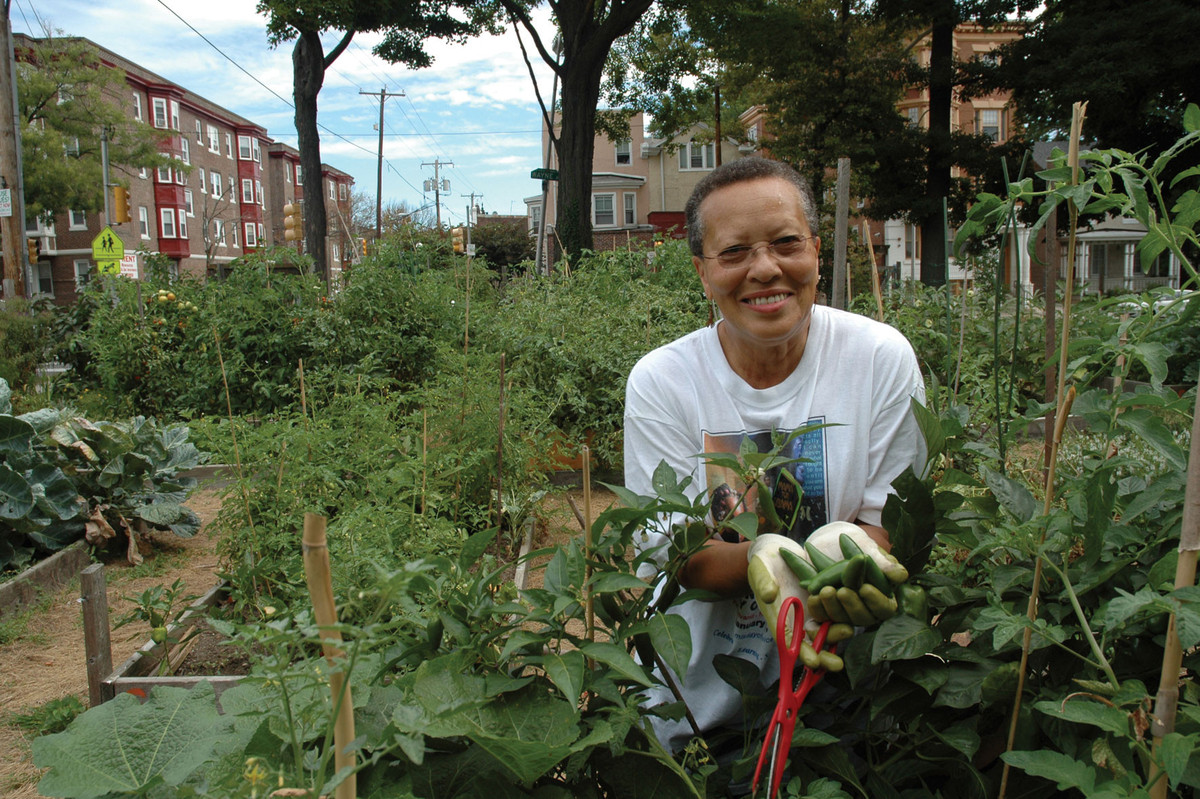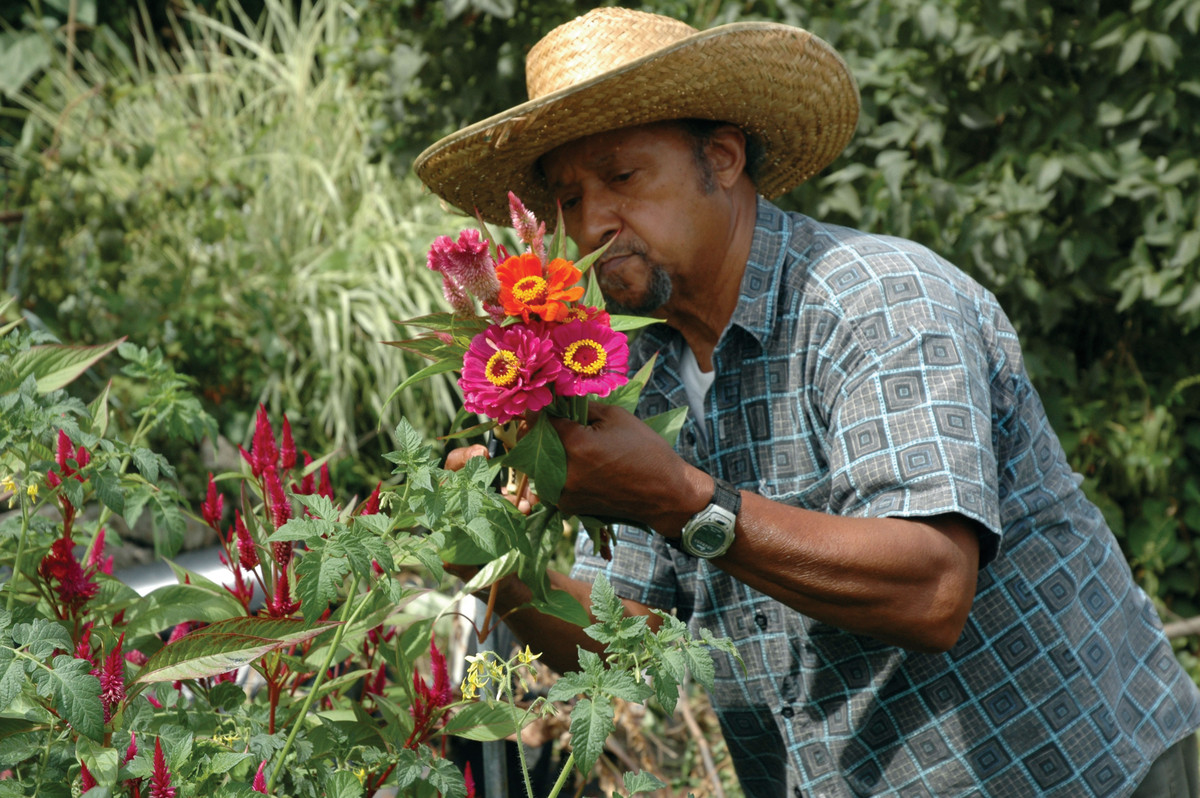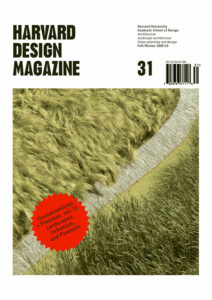Lush Lots: Everyday Urban Agriculture
Tomatoes always seem to taste better when you are acquainted with the person who grew them, especially when that person is you. Many Americans have never tasted a “real” tomato, vine ripened no more than a day or two before being eaten. Corn tastes best when you get the water boiling minutes before you pick it. The joys of fresh produce, along with those of saving money and building community, help explain the recent growth of farmers’ markets and of the fascination with urban agriculture.
Growing food in cities promises the delight of being acquainted with what we eat and its origins more intimately, and of feeling less guilty for our (usually) smaller ecological footprint, since it is typically organic and cuts down on waste. It is something many city dwellers already experience through community gardens and new entrepreneurial urban farms. As cities face the environmental, economic, and social challenges of the 21st century, including hunger, diabetes, and dependence on global industrial food systems based on fossil fuels, local food production will be more and more important for building food security. How do we achieve this? What do the hundreds of community gardens and farms we recently studied in Philadelphia tell us about the sustainability of urban agriculture and urban life?
In Philadelphia, neighbors breathe in scents of the butterfly bushes and basil of community gardens where once were trash-strewn lots; they pride themselves on reviving and beautifying their blocks. At the farmers’ market at City Hall, adults delight in buying spinach and squash from teenagers who farm a former corner of their high-school soccer field and who actually eat sorrel. At a pig roast, children dancing to bomba drums and eating pigeon peas with rice make grandmothers feel gratified that their garden is preserving their Puerto Rican culture. On the urban farm, apprentices watch honeybees returning to the city to pollinate our food and future.
During the summer of 2008, we and our research assistants found all this when we surveyed Philadelphia’s past and present community gardens and farms.1 These ranged from allotment gardens with hundreds of plots on parkland, to small patches between row houses colonized by one or two people, to gardens on vacant lots whose caretakers had moved on. We found over three hundred active gardens where approximately 2,000 people were growing food. We counted thirty-three acres under food production, and estimate production of 2.2 million pounds of vegetables worth $4.4 million.2 Some people garden for the low-impact exercise, others for good nutrition, still others for their mental health. But all had one thing in common: They love growing their own fresh food, love how it tastes, and more often than not grow a surplus that they love to give away.
Meanwhile, large-scale professional planning and design for urban agriculture and sustainable food systems are in a speculative phase, at least in the global North. Designers understandably fancy vivid renderings projecting skyscraper farms or golden fields of wheat and acres of corn across vast swaths of the inner city. Our architecture and planning students dream of inserting Havana’s roof gardens, community farms, and corner produce stands into Pittsburgh and New Orleans. The impulse seems right, since scaling up urban agriculture holds real potential for restoring local ecology, economies, and health, and we have much to learn from the experience of cities in the global South (see in particular the work of the Resource Centres on Urban Agriculture and Food Security in Africa, South America, and Asia).3 But there are good reasons why our designs for multimillion-dollar “vertical” farms and bulk commodity—or worse, tropical—crops in Manhattan and Chicago have not been built or tested. They have little grounding in the reality and pleasure of sustainable urban agriculture, which is solidly grounded in local climates and soils.
The reality is that most urban agriculture in the United States, Canada, and Europe takes the form of community gardening. This is an “everyday urbanism,” largely disconnected from the world of professional design.4 Far from our dreams of vertical farming or vast tracts of cropland, today’s city farms plant higher-value vegetables intensively in limited space, growing vastly more food per acre than do industrial farms. Yet urban agriculture in the global North remains an economically marginal activity, typically subsisting with the aid of philanthropists.
The inner city presents our greatest challenges for food security, but it is not without agricultural assets. Growing food connects people to their environment and to their neighbors, nurturing trust and relationships that tie together social, economic, and ecological systems. Many people garden as a deliberate strategy to feed people who lack regular access to fresh, nutritious food. Community gardens in Philadelphia concentrate overwhelmingly in low-wealth neighborhoods ravished by disinvestment, where people do their best in circumstances that most Americans would find intolerable. Often poor people are repositories of vast agricultural knowledge, since a large (although shrinking) proportion of gardeners arrived via the great migrations of African Americans and Puerto Ricans or later waves of immigrants from farming regions of the world. This knowledge is a rich, largely unreported ore in poor communities; it counters the images of the “inner city” offered by the evening news or TV shows like The Wire. Many of the social networks in these neighborhoods are surprisingly resilient, often coalescing around food production sites.
A dozen years ago, Philadelphia was home to the most robust urban gardening support system in the United States: The Pennsylvania Horticultural Society and Penn State Cooperative Agricultural Extension supported 500 food-producing gardens and hundreds more that grew flowers and shade trees. In the 1980s and ’90s, the rationale for these programs lay in helping bring people together to take back vacant lots and build community in places devastated by deindustrialization. During the economic boom of the late ’90s, public and philanthropic dollars for these programs were withdrawn, and their support system mostly dismantled. Today, the Horticultural Society supports roughly forty community gardens and three farms through the City Harvest program, which delivers seedlings raised in the Philadelphia County Prison greenhouse to gardeners who set aside plots to grow vegetables they deliver to local food banks. This is the formal side of community gardens’ role in building local food security. Yet there is a much larger informal side of food security in gardens not supported by any institution, since gardeners have proven remarkably resilient in the face of declining support. This is the story of most community gardening in Philadelphia.
The Gift
When we asked Earl Johnson if he ate most of the food he grows on his 2,400-square-foot (5% of an acre) lot in the Strawberry Mansion section of North Philadelphia, he replied, “I only eat some of the corn. The rest I give away to people who come by and ask for it. There are a lot of hungry people in this neighborhood.”
Like many older African Americans, Earl grew up in the rural South and moved to the city in the Second Great Migration. He is retired and grows collards, string beans, and tomatoes on the site of three demolished row houses owned by the Department of Public Property and two private parties. Earl has gardened in the neighborhood for twenty years in three or four different places—city inspectors have a habit of bulldozing gardens in the dormant season. As other older men told us in North Philadelphia, growing food is “in the blood,” part of what it means to be “a real Georgia boy.”
Earl’s greatest satisfaction is tending his garden. Wandering through it, we got to try the most luscious blackberries we’d ever tasted in Philadelphia. It was hard to imagine why Earl did not devour the fruit himself. Instead, he invited the neighborhood kids into the garden to pick and eat them. For him the only cardinal sin is greed. People were not allowed to pick more than they could eat on the spot, and if they did they were not invited back. “Leave enough for others.” For Earl, the pleasure of the gift relationship includes watching young people learning to share.
There is perhaps a more somber gratification in sustaining people of a community whose social and economic profile should test any American’s notion of survival. By all measures, Strawberry Mansion is one of the most distressed neighborhoods in the city. In 2000, the median household income was $14,775, and over 30% of properties were vacant. In 2007, the median home sales price was just $22,000. The west side of North Philadelphia is one of the centers of homicide in the city; murder occurs there at a rate that led the nation in 2006. More than 40% of area households receive assistance with their heating bills.5 People in neighborhoods like Strawberry Mansion depend on food banks for their regular “shopping,” in a food access system that no longer serves “emergencies,” unless we consider hunger a constant emergency in the United States. Community gardens help make up for that period in the year when food access programs pump the fewest calories into poor communities: When school is out, and free breakfasts and lunches are not available.
There are hundreds of Earl Johnsons across Philadelphia, especially in its low-wealth communities. Gardeners, we have found, are for the most part generous people. In poor neighborhoods, they are usually grandparents with the time and agricultural backgrounds that enable them to feed their extended families, neighbors, church members, and people who just happen by. We heard stories of some gardeners connecting young mothers to food stamp enrollment; the federal Women, Infants, and Children (WIC) program; and food cupboards.
We also found an emerging trend of thirty- and forty-something women stepping into this role, women who pointed to rising food prices and the need to feed their own and other people’s children as their reasons to start gardening. Nonetheless, the aging of people with farming knowledge and a tradition of feeding neighbors raises important challenges to the sustainability of urban agriculture, especially in poor minority communities. This is also true of gardens that are more institutionalized than Earl’s.
Food Culture
At Las Parcelas garden in the Norris Square section of Kensington, on the other side of North Philadelphia, brilliant murals depict a romanticized picture of life in Puerto Rico, while the brightly painted casita, with its outdoor kitchen and shaded porch and patio, draws people in to rest. More than a community garden, Las Parcelas hosts formal and informal youth programs to teach children about their heritage. Across the street, the gardeners have built Villa Africana Colobo, a series of huts and a room for telling stories that connect Puerto Rican children to their African roots and their African American neighbors. Garden director Iris Brown and her friend Tomasita Romero plant vegetables brought from Africa to the Caribbean—yams, okra, and chilies. In the bed along the sidewalk, they grow native Puerto Rican herbs that women up the block use in homeopathic medicine.6
For Iris and Tomasita, the pleasure of urban agriculture stems from the joy of making the neighborhood in their own image and of preserving their culture in the process. Tomasita moved to Philadelphia in the 1940s, initially working as a cook in a small hospital, later in a public school. In the 1970s, Kensington’s textile mills shut down. By the mid-1980s, not long after Iris came to Norris Square via New York, the lots that are now Las Parcelas hosted one of the largest open-air cocaine and heroin markets in Philadelphia. Tomasita and her neighbors stood on corners and held candlelit vigils to discourage dealers and buyers. Then one day the Drug Enforcement Administration arrested over fifty men. The women and their neighbors now had a chance to transform the lots, but some had also lost family members to far away federal prisons. The gardens they would build provided social support, as they cooked, sewed, and raised children and grandchildren together.
In partnership with Penn State and later the Horticultural Society, the women of the Norris Square Neighborhood Project developed one of the landmark community gardens of Philadelphia. Today they call themselves Grupo Motivos,7 women motivated to keep their culture alive through horticulture and food culture. The kids from down the block who follow Iris around Las Parcelas range from four to ten years old. They desperately want to sleep over in the casita. Teenagers are fewer in the garden, but they show up for the party at harvest time for pigeon peas and yucca. For them, bomba dancing is a traditional courting ritual hip enough to perform.
Las Parcelas participates in City Harvest. On a late summer Thursday, Tomasita wields a machete to harvest greens for the nearby Saint Francis Inn, which feeds the largest group of heroin users in the city. But she and Iris have bigger dreams. About eight years ago, Iris visited Cuba with the Horticultural Society and returned inspired by the ways in which people had developed an “edible city,” with farms and gardens on rooftops, parks, and plazas, supplying local produce stands that fed entire neighborhoods.8 Around that same time, the District Attorney gave them a building adjacent to Las Parcelas, seized in a drug-related case. Grupo Motivos envisioned a women’s center with a café offering Puerto Rican cooking classes and delicacies straight from the garden, and they started a catering service to raise the money. With their brothers, they built a farm stand. They want to build a greenhouse to extend the season, grow more Puerto Rican plants, and raise the spirits of people who still find the Philadelphia winter depressing. Iris and Tomasita know their gardens can be greater engines of community food security, partly because the gardens have gotten them through hard times before, sustaining their bodies, friendships, and culture. They also know because they have visited Mill Creek Farm.
Farming the Garden
Arriving at Mill Creek Farm in West Philadelphia, local elementary school students are amazed to see a banana tree growing.9 A chorus of “Eeww!” erupts when they are told that the tree is kept warm by the compost pile and the sludge from the toilet in the nearby shed made of adobe-like cob and powered by solar panels. By the end of the morning, most find urban farming strange but fun.
Mill Creek is part of the new wave of agriculture in American cities. In 2005 Johanna Rosen and Jade Walker responded with the winning proposal to an RFP issued by the Philadelphia Water Department, for which this was a storm-water management project. The farm is one-half of a parcel that had long been vacant, two-thirds of an acre in total. The Brown Street Community Garden, established twenty-seven years ago, occupies the other half. The Mill Creek sewer runs directly underneath. In 1960, the sewer collapsed a block away, killing four people and ruining nearby houses. In the 1880s, the sewer line was installed in the creek bed, the valley was filled in with coal ash, and houses were built on top. The badly compacted ash washed out, leaving the pipe cracking and leaking and the foundations on top unstable. MIT landscape architecture professor Anne Whiston Spirn documented the neighborhood and its environmental injustices in the West Philadelphia Landscape Project.10
Of the larger community gardens we visited, Brown Street had the least visible leadership. Here one finds no-frills gardening—simply a place for neighbors to have a plot of land to grow food, although the young women at the adjacent farm have lent informal support with their compost heap and barbecue grill. One gardener, an African American man in his late sixties, explained that he grew most of his food for the summer, supplementing it with very occasional trips to the market to buy meat. Between wads of tobacco, he bragged of wooing neighborhood women with his harvest. We did not pry further about these sorts of pleasures.
Mill Creek Farm’s mission is both agricultural and educational. It grows a variety of vegetables and herbs for markets and restaurants but also sells produce at below market prices at its farm stand to increase access to fresh food in this poor community. Jade and Johanna are able to do so because they apply for grants to support their nonprofit organization and its mission of educating children about the food supply. Contrary to common belief, there is a growing demand for healthy, organic food in poor neighborhoods. Many of their customers are delighted to be able to buy affordable West Philadelphia okra, their most popular crop.
On many spring and summer days, the farm is filled with kids exclaiming their ambivalence through fear, disgust, and delight at the composting toilet, beehives, and worms. Few have ever seen how food is grown, so the revelation that carrots come from the dirt in the neighborhood is startling for many. This is the joy of discovery, of learning how people and cities are sustained.
Most urban farms are experimental, searching for the right combination of funding, products, and programs that will ensure their success. The oldest in Philadelphia, Greensgrow Farm, is celebrating its eleventh anniversary. Located on the site of a former steel galvanizing plant, it grows lettuce and basil hydroponically, heirloom tomatoes in raised beds, and potted plants in greenhouses. Greensgrow has diversified its activities to include vermicomposting, biodiesel production, a Community Supported Agriculture (CSA) arrangement with a network of rural farms, a farm stand, a new community kitchen, and its Honey from the Hood. It supplies mostly middle-class pleasures, as does Weavers Way Farm, located in a historic arboretum, although Weavers Way also supports Martin Luther King High School Farm, whose students sell their produce at the City Hall Farmers’ Market. One of the student farmers at MLK found happiness in discovering that sorrel tastes like sour apple Skittles.
The future of urban agriculture is at these farms and others like them on vacant lots, parkland, and in the densest cities on rooftops and other mostly horizontal spaces of the urban landscape. But it is also in the community gardens that make up a vital if sometimes not as sexy part of city food production. Some people go to great lengths to distinguish between “farming” and “gardening,” but we believe this distinction has little value if creating food security and local economies is our goal. Many of the gardeners we met call themselves “farmers,” only some jokingly. Community gardens make significant contributions to household and community food economies, and some gardeners we encountered sell their harvest. Indeed, one family in the Philadelphia’s second-largest allotment garden grows as much as the city’s third-biggest farm, selling at a downtown farmers’ market but also giving much away for free to fellow parishioners at its church.11 We also submit that the hundreds of gardeners who tend their plots with the express goal of providing food for hungry friends, family, and strangers are performing an entrepreneurial task. While they may not profit financially, most are duly compensated by the profound pleasure of sharing health and happiness through food.
The Real Joys of Urban Agriculture
Spending some down and dirty time in the local community garden can help get designers in touch with the realities of everyday urban agriculture. It will likely make the enterprise seem both more challenging and more pleasurable than they had imagined.
Recently we have watched with interest and amusement the extensive media coverage of vertical farming. Finally, designers are integrating food into urban projects. In alluring computer-generated images, futuristic skyscrapers powered by renewable energy sources recycle wastewater from the entire city and house production systems that can feed 50,000 people in completely controlled antiseptic conditions. What’s not to like? As our dystopic colleague Catherine Bonier pointed out, “What they never show you is the basement where furnaces and spaces for immigrant workers sit cheek by jowl.” One can imagine the ConAgra Tower or Archer Daniels Midland Food Production Center dominating the skyline of Manhattan—such companies may be the only ones with the capital to build these towers. In the paranoid fantasy of science fiction writers, one can see the Soylent Green Tower producing a continuous diet of Happy Meals for the satiated residents of New York.
Vertical farming is handicapped: It is a capitalintensive strategy for a labor-intensive industry. It may make sense for Dubai, the new eco-city of Dongtan, or perhaps Midtown Manhattan someday, but not for Philadelphia, Detroit, or Chicago, where both land and labor are abundant.
What is more difficult to imagine in skyscraper farms is the quality of life we found at many community gardens and urban farms. The Philadelphia experience is a more ordinary story than agriculture in hermetically sealed towers designed by starchitects or tropical roof gardens across Havana. But it is a more real story for American cities in particular. It is the story of everyday, organic urbanism in which people alter their own neighborhoods in both surprising and mundane ways. It is also the story of people’s efforts to overcome deindustrialization and its devastating consequent ills: unemployment, poverty, hunger, obesity, asthma, and crime.
Our own speculative proposal for feeding the global North builds on the Philadelphia experience. For models of planning and community development, we look to the leading urban farming and community gardening programs of Vancouver, Detroit, Milwaukee, and Kansas City12; and to Britain—to Middlesbrough’s Town Meal designed by André Viljoen and Katrin Bohn and London’s new Capital Growth campaign. This last effort is not a financial scheme but rather an effort to harness the energies of citizens and community organizations to grow food in 2,012 new urban spaces by the year 2012.13 We envision more processing and canning to preserve the summer’s bounty and low-tech greenhouses to keep food growing through the winter. We imagine the emergence of a more humane city in which relationships and the exchange of food and agricultural traditions are valued, whether cash changes hands or not. Urban agriculture is a solution based more on people than on technology. It is more “kitchen capitalism” than financial capitalism. It will not be a panacea or a quick fix. It will be, however, one important way people in cities feed themselves and each other in the future, and derive pleasure from doing so.



